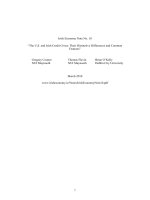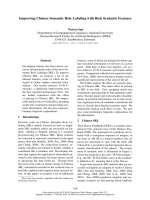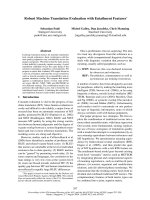DRY-FARM AREAS.--GENERAL CLIMATIC FEATURES ppt
Bạn đang xem bản rút gọn của tài liệu. Xem và tải ngay bản đầy đủ của tài liệu tại đây (119.19 KB, 11 trang )
DRY-FARM AREAS GENERAL CLIMATIC
FEATURES
The dry-farm territory of the United States stretches from the
Pacific seaboard to the 96th parallel of longitude, and from the
Canadian to the Mexican boundary, making a total area of nearly
1,800,000 square miles. This immense territory is far from being a
vast level plain. On the extreme east is the Great Plains region of
the Mississippi Valley which is a comparatively uniform country of
rolling hills, but no mountains. At a point about one third of the
whole distance westward the whole land is lifted skyward by the
Rocky Mountains, which cross the country from south to northwest.
Here are innumerable peaks, canons, high table-lands, roaring
torrents, and quiet mountain valleys. West of the Rockies is the
great depression known as the Great Basin, which has no outlet to
the ocean. It is essentially a gigantic level lake floor traversed
in many directions by mountain ranges that are offshoots from the
backbone of the Rockies. South of the Great Basin are the high
plateaus, into which many great chasms are cut, the best known and
largest of which is the great Canon of the Colorado. North and east
of the Great Basin is the Columbia River Basin characterized by
basaltic rolling plains and broken mountain country. To the west,
the floor of the Great Basin is lifted up into the region of eternal
snow by the Sierra Nevada Mountains, which north of Nevada are known
as the Cascades. On the west, the Sierra Nevadas slope gently,
through intervening valleys and minor mountain ranges, into the
Pacific Ocean. It would be difficult to imagine a more diversified
topography than is possessed by the dry-farm territory of the United
States.
Uniform climatic conditions are not to be expected over such a
broken country. The chief determining factors of climate latitude,
relative distribution of land and water, elevation, prevailing
winds swing between such large extremes that of necessity the
climatic conditions of different sections are widely divergent.
Dry-farming is so intimately related to climate that the typical
climatic variations must be pointed out.
The total annual precipitation is directly influenced by the land
topography, especially by the great mountain ranges. On the east of
the Rocky Mountains is the sub-humid district, which receives from
20 to 30 inches of rainfall annually; over the Rockies themselves,
semiarid conditions prevail; in the Great Basin, hemmed in by the
Rockies on the east and the Sierra Nevadas on the west, more arid
conditions predominate; to the west, over the Sierras and down to
the seacoast, semiarid to sub-humid conditions are again found.
Seasonal distribution of rainfall
It is doubtless true that the total annual precipitation is the
chief factor in determining the success of dry-farming. However, the
distribution of the rainfall throughout the year is also of great
importance, and should be known by the farmer. A small rainfall,
coming at the most desirable season, will have greater
crop-producing power than a very much larger rainfall poorly
distributed. Moreover, the methods of tillage to be employed where
most of the precipitation comes in winter must be considerably
different from those used where the bulk of the precipitation comes
in the summer. The successful dry-farmer must know the average
annual precipitation, and also the average seasonal distribution of
the rainfall, over the land which he intends to dry-farm before he
can safely choose his cultural methods.
With reference to the monthly distribution of the precipitation over
the dry-farm territory of the United States, Henry of the United
States Weather Bureau recognizes five distinct types; namely: (1)
Pacific, (2) Sub-Pacific, (3) Arizona, (4) the Northern Rocky
Mountain and Eastern Foothills, and (5) the Plains Type:
_"The Pacific Type _This type is found in all of the territory
west of the Cascade and Sierra Nevada ranges, and also obtains in a
fringe of country to the eastward of the mountain summits. The
distinguishing characteristic of the Pacific type is a wet season,
extending from October to March, and a practically rainless summer,
except in northern California and parts of Oregon and Washington.
About half of the yearly precipitation comes in the months of
December, January, and February, the remaining half being
distributed throughout the seven months September, October,
November, March, April, May, and June."
_"Sub-Pacific Type _The term 'Sub-Pacific' has been given to that
type of rainfall which obtains over eastern Washington, Nevada, and
Utah. The influences that control the precipitation of this region
are much similar to those that prevail west of the Sierra Nevada and
Cascade ranges. There is not, however, as in the eastern type, a
steady diminution in the precipitation with the approach of spring,
but rather a culmination in the precipitation."
_"Arizona Type _The Arizona Type, so called because it is more
fully developed in that territory than elsewhere, prevails over
Arizona, New Mexico, and a small portion of eastern Utah and Nevada.
This type differs from all others in the fact that about 35 per cent
of the rain falls in July and August. May and June are generally the
months of least rainfall."
_"The Northern Rocky Mountain and Eastern Foothills Type _This
type is closely allied to that of the plains to the eastward, and
the bulk of the rain falls in the foothills of the region in April
and May; in Montana, in May and June."
_"The Plains Type _This type embraces the greater part of the
Dakotas, Nebraska, Kansas; Oklahoma, the Panhandle of Texas, and all
the great corn and wheat states of the interior valleys. This region
is characterized by a scant winter precipitation over the northern
states and moderately heavy rains during the growing season. The.
bulk of the rains comes in May, June, and July."
This classification emphasizes the great variation in distribution
of rainfall over the dry-farm territory of the country. West of the
Rocky Mountains the precipitation comes chiefly in winter and
spring, leaving the summers rainless; while east of the Rockies, the
winters are somewhat rainless and the precipitation comes chiefly in
spring and summer. The Arizona type stands midway between these
types. This variation in the distribution of the rainfall requires
that different methods be employed in storing and conserving the
rainfall for crop production. The adaptation of cultural methods to
the seasonal distribution of rainfall will be discussed hereafter.
Snowfall
Closely related to the distribution of the rainfall and the average
annual temperature is the snowfall. Wherever a relatively large
winter precipitation occurs, the dry-farmer is benefited if it comes
in the form of snow. The fall-planted seeds are better protected by
the snow; the evaporation is lower and it appears that the soil is
improved by the annual covering of snow. In any case, the methods of
culture are in a measure dependent upon the amount of snowfall and
the length of time that it lies upon the ground.
Snow falls over most of the dry-farm territory, excepting the
lowlands of California, the immediate Pacific coast, and other
districts where the average annual temperature is high. The heaviest
snowfall is in the intermountain district, from the west slope of
the Sierra Nevadas to the east slope of the Rockies. The degree of
snowfall on the agricultural lands is very variable and dependent
upon local conditions. Snow falls upon all the high mountain ranges.
Temperature
With the exceptions of portions of California, Arizona, and Texas
the average annual surface temperature of the dry-farm territory of
the United States ranges from 40 deg to 55 deg F. The average is not
far from 45 deg F. This places most of the dry-farm territory in the
class of cold regions, though a small area on the extreme east
border may be classed as temperate, and parts of California and
Arizona as warm. The range in temperature from the highest in summer
to the lowest in winter is considerable, but not widely different
from other similar parts of the United States. The range is greatest
in the interior mountainous districts, and lowest along the
seacoast. The daily range of the highest and lowest temperatures for
any one day is generally higher over dry-farm sections than over
humid districts. In the Plateau regions of the semiarid country the
average daily variation is from 30 to 35 deg F., while east of the
Mississippi it is only about 20 deg F. This greater daily range is
chiefly due to the clear skies and scant vegetation which facilitate
excessive warming by day and cooling by night.
The important temperature question for the dry-farmer is whether the
growing season is sufficiently warm and long to permit the maturing
of crops. There are few places, even at high altitudes in the region
considered, where the summer temperature is so low as to retard the
growth of plants. Likewise, the first and last killing frosts are
ordinarily so far apart as to allow an ample growing season. It must
be remembered that frosts are governed very largely by local
topographic features, and must be known from a local point of view.
It is a general law that frosts are more likely to occur in valleys
than on hillsides, owing to the downward drainage of the cooled air.
Further, the danger of frost increases with the altitude. In
general, the last killing frost in spring over the dry-farm
territory varies from March 15 to May 29, and the first killing
frost in autumn from September 15 to November 15. These limits
permit of the maturing of all ordinary farm crops, especially the
grain crops.
Relative humidity
At a definite temperature, the atmosphere can hold only a certain
amount of water vapor. When the air can hold no more, it is said to
be saturated. When it is not saturated, the amount of water vapor
actually held by the air is expressed in percentages of the quantity
required for saturation. A relative humidity of 100 per cent means
that the air is saturated; of 50 per cent, that it is only one half
saturated. The drier the air is, the more rapidly does the water
evaporate into it. To the dry-farmer, therefore, the relative
humidity or degree of dryness of the air is of very great
importance. According to Professor Henry, the chief characteristics
of the geographic distribution of relative humidity in the United
States are as follows:
(1) Along the coasts there is a belt of high humidity at all
seasons, the percentage of saturation ranging from 75 to 80 per
cent.
(2) Inland, from about the 70th meridian eastward to the Atlantic
coast, the amount varies between 70 and 75 per cent.
(3) The dry region is in the Southwest, where the average annual
value is not over 50 per cent. In this region are included Arizona,
New Mexico, western Colorado, and the greater portion of both Utah
and Nevada. The amount of annual relative humidity in the remaining
portion of the elevated district, between the 100th meridian on the
east to the Sierra Nevada and the Cascades on the west, varies
between 55 and 65 per cent. In July, August, and September, the mean
values in the Southwest sink as low as 20 to 30 per cent, while
along the Pacific coast districts they continue about 80 per cent
the year round. In the Atlantic coast districts, and generally east
from the Mississippi River, the variation from month to month is not
great. April is probably the driest month of the year.
The air of the dry-farm territory, therefore, on the whole, contains
considerably less than two thirds the amount of moisture carried by
the air of the humid states. This means that evaporation from plant
leaves and soil surfaces will go on more rapidly in semiarid than in
humid regions. Against this danger, which cannot he controlled, the
dry-farmer must take special precautions.
Sunshine
The amount of sunshine in a dry-farm section is also of importance.
Direct sunshine promotes plant growth, but at the same time it
accelerates the evaporation of water from the soil. The whole
dry-farm territory receives more sunshine than do the humid
sections. In fact, the amount of sunshine may roughly be said to
increase as the annual rainfall decreases. Over the larger part of
the arid and semiarid sections the sun shines over 70 per cent of
the time.
Winds
The winds of any locality, owing to their moisture-dissipating
power play an important part in the success of dry-farming. A
persistent wind will offset much of the benefit of a heavy rainfall
and careful cultivation. While great general laws have been
formulated regarding the movements of the atmosphere, they are of
minor value in judging the effect of wind on any farming district.
Local observations, however, may enable the farmer to estimate the
probable effect of the winds and thus to formulate proper cultural
means of protection. In general, those living in a district are able
to describe it without special observations as windy or quiet. In
the dry-farm territory of the United States the one great region of
relatively high and persistent winds is the Great Plains region east
of the Rocky Mountains. Dry-farmers in that section will of
necessity be obliged to adopt cultural methods that will prevent the
excessive evaporation naturally induced by the unhindered wind, and
the possible blowing of well-tilled fallow land.
Summary
The dry-farm territory is characterized by a low rainfall, averaging
between 10 and 20 inches, the distribution of which falls into two
distinct types: a heavy winter and spring with a light summer
precipitation, and a heavy spring and summer with a light winter
precipitation. Snow falls over most of the territory, but does not
lie long outside of the mountain states. The whole dry-farm
territory may be classed as temperate to cold; relatively high and
persistent winds blow only over the Great Plains, though local
conditions cause strong regular winds in many other places; the air
is dry and the sunshine is very abundant. In brief, little water
falls upon the dry-farm territory, and the climatic factors are of a
nature to cause rapid evaporation.
In view of this knowledge, it is not surprising that thousands of
farmers, employing, often carelessly agricultural methods developed
in humid sections, have found only hardships and poverty on the
present dry-farm empire of the United States.
Drouth
Drouth is said to be the arch enemy of the dry-farmer, but few agree
upon its meaning. For the purposes of this volume, drouth may be
defined as a condition under which crops fail to mature because of
an insufficient supply of water. Providence has generally been
charged with causing drouths, but under the above definition, man is
usually the cause. Occasionally, relatively dry years occur, but
they are seldom dry enough to cause crop failures if proper methods
of farming have been practiced. There are four chief causes of
drouth: (1) Improper or careless preparation of the soil; (2)
failure to store the natural precipitation in the soil; (3) failure
to apply proper cultural methods for keeping the moisture in the
soil until needed by plants, and (4) sowing too much seed for the
available soil-moisture.
Crop failures due to untimely frosts, blizzards, cyclones,
tornadoes, or hail may perhaps be charged to Providence, but the
dry-farmer must accept the responsibility for any crop injury
resulting from drouth. A fairly accurate knowledge of the climatic
conditions of the district, a good understanding of the principles
of agriculture without irrigation under a low rainfall, and a
vigorous application of these principles as adapted to the local
climatic conditions will make dry-farm failures a rarity.









